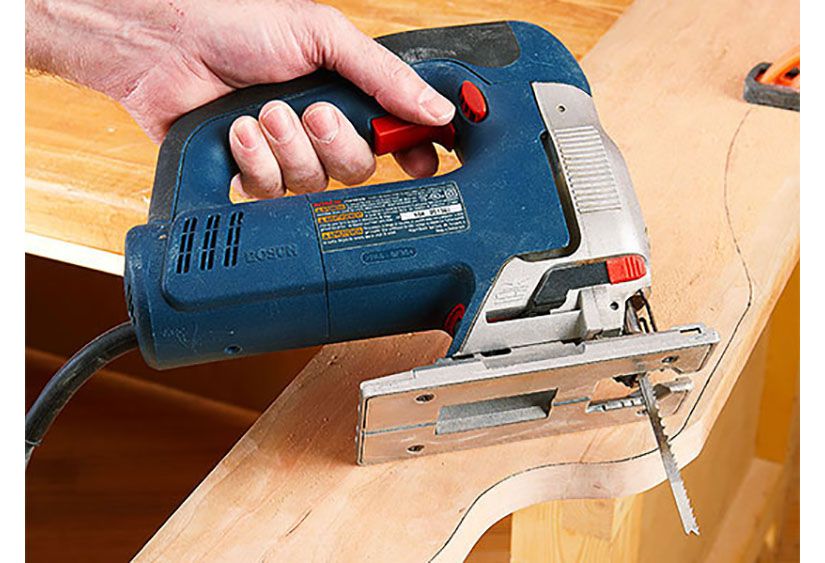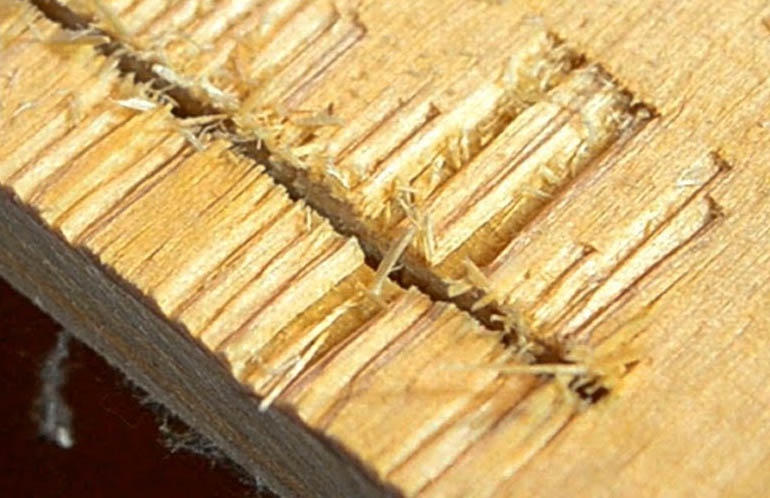Have you ever wondered if a jigsaw can cut plywood? Well, you’re in the right place! In this article, we’ll explore the capabilities of a jigsaw when it comes to tackling plywood.
Plywood is a popular material used in various DIY projects, from building furniture to creating decorative pieces. But can a jigsaw, known for its versatility in cutting curves and intricate shapes, handle the task? Let’s find out!
Whether you’re a woodworking enthusiast or a curious DIYer, we’ll dive into the details of using a jigsaw to cut plywood, providing you with the knowledge you need to tackle your next project with confidence. So let’s get started!
- Secure the plywood using clamps or a workbench.
- Mark the cutting line clearly.
- Select the right blade for plywood.
- Start cutting slowly and steadily.
- Use a guide or a straight edge for straight cuts.
- Sand the edges for a smooth finish.

Can a Jigsaw Cut Plywood?
When it comes to woodworking, there are a variety of tools that can be used to make precise cuts in different materials. One such tool is the jigsaw, known for its versatility and ability to cut curves and intricate shapes. But can a jigsaw cut plywood? In this article, we will explore the capabilities of a jigsaw when it comes to cutting plywood and provide you with valuable information and tips on how to achieve clean and accurate cuts.
The Basics of Using a Jigsaw for Cutting Plywood
Before delving into the specifics of cutting plywood with a jigsaw, it’s important to understand the basics. A jigsaw is a handheld power tool that features a narrow blade that moves in an up-and-down motion. This motion allows the blade to cut through various materials, including plywood.
When it comes to cutting plywood with a jigsaw, the process is fairly straightforward. Start by marking the cut line on the plywood using a pencil or a fine-tip marker. This will serve as a guide for your jigsaw. It’s important to measure and mark accurately to ensure precise cuts. Next, secure the plywood firmly to a workbench or support surface to prevent any movement during the cutting process. Finally, insert a plywood-cutting blade into the jigsaw and align it with the marked cut line. Turn on the jigsaw and gently guide it along the cut line, allowing the blade to do the work. Maintain a steady pace and let the jigsaw’s blade move at its own speed to prevent overheating and ensure better cutting results.
The Advantages of Using a Jigsaw for Cutting Plywood
1. Versatility: One of the main advantages of using a jigsaw for cutting plywood is its versatility. Unlike other tools, such as a table saw or circular saw, the jigsaw allows for curved cuts and intricate shapes to be achieved easily.
2. Maneuverability: Due to its handheld nature and lightweight design, a jigsaw offers great maneuverability. This makes it easier to navigate around tight corners and make precise cuts in plywood.
3. Accessible for Beginners: If you’re just starting out in woodworking, a jigsaw can be an excellent tool to use for cutting plywood. It requires minimal setup and can be easily controlled, even by those with little to no experience.
Tips for Achieving Clean and Accurate Cuts
1. Use the Right Blade: Choosing the right blade for cutting plywood is crucial for achieving clean and accurate cuts. Opt for a blade specifically designed for cutting this material. Typically, a blade with a high tooth count and fine teeth will result in cleaner cuts.
2. Secure the Plywood: To prevent any movement or vibration that may affect the precision of your cuts, ensure that the plywood is securely clamped or held in place during the cutting process. This will help maintain stability and accuracy.
3. Take Your Time: It’s important not to rush the cutting process. Take your time and guide the jigsaw steadily along the cut line. Allow the blade to do the work and avoid forcing it through the plywood, as this can lead to splintering or uneven cuts.
Common Uses for a Jigsaw in Plywood Projects
1. Furniture Making: Whether you’re creating intricate designs in plywood for tabletops or cutting out shapes for chairs and bookshelves, a jigsaw can be a valuable tool in furniture making projects.
2. Home Décor: From wall art to personalized signs, a jigsaw can help you bring your creative ideas to life by cutting precise and unique shapes in plywood for various home décor projects.
3. Craft Projects: If you enjoy crafting, a jigsaw can be a versatile tool for cutting plywood for projects like jewelry boxes, picture frames, and miniature models.
Using a Jigsaw for Plywood: Safety Precautions
While using a jigsaw for cutting plywood can be a rewarding experience, it’s important to prioritize safety. Here are some safety precautions to keep in mind:
1. Wear Safety Gear:
Always wear safety goggles to protect your eyes from flying debris. Additionally, consider using ear protection to minimize noise exposure and gloves to protect your hands.
2. Secure the Workpiece:
Make sure the plywood is securely clamped or held in place to prevent any movement during the cutting process. This will help minimize the risk of accidents or inaccurate cuts.
3. Follow Manufacturer’s Instructions:
Read and follow the manufacturer’s instructions for both the jigsaw and the blades. This will ensure the safe and proper operation of the tool.
4. Use Proper Technique:
Always maintain a firm grip on the jigsaw and guide it steadily along the cut line. Avoid placing your hands in the path of the blade and never force the jigsaw through the plywood.
5. Disconnect Power:
When changing blades or adjusting the jigsaw, make sure to disconnect it from the power source. This will prevent any accidental starts or injuries.
In Conclusion
A jigsaw can indeed cut plywood, offering flexibility and ease of use for a variety of woodworking projects. By following the proper techniques and safety precautions, you can achieve clean and accurate cuts with this versatile tool. Whether you’re a beginner or an experienced woodworker, a jigsaw can be a valuable addition to your workshop, allowing you to unleash your creativity and bring your plywood projects to life.
Can a Jigsaw Cut Plywood?
- Yes, a jigsaw can cut plywood effectively.
- However, it is important to use the right type of blade for cutting plywood.
- Choose a fine-toothed blade with a high TPI (teeth per inch) for smoother cuts.
- Taking your time and using the proper technique will result in clean and precise plywood cuts.
- Remember to wear safety goggles and follow proper safety precautions when using a jigsaw.
Frequently Asked Questions
In this section, we will address common questions about using a jigsaw to cut plywood. Whether you’re a DIY enthusiast or a woodworking beginner, these answers will help you understand the capabilities and limitations of a jigsaw when it comes to cutting plywood.
Can a jigsaw cut through plywood?
Yes, a jigsaw is capable of cutting through plywood. However, there are a few considerations to keep in mind. First, make sure you have the right blade for the job. A fine-toothed blade with at least 10 teeth per inch is recommended for cleaner cuts in plywood. Second, adjust the speed of your jigsaw to a lower setting to prevent splintering and chipping. Lastly, take your time and guide the jigsaw along the cut line steadily to achieve accurate and precise cuts.
However, it is important to note that a jigsaw is typically used for making curved or intricate cuts in plywood, rather than straight cuts. For straight cuts, a circular saw or a table saw may be more suitable, as they offer better stability and precision. Consider the nature of your project and the specific cuts you need to make before deciding on the appropriate tool.
What thickness of plywood can a jigsaw cut?
A jigsaw can cut plywood of various thicknesses, depending on the power and capabilities of your specific jigsaw model. In general, most standard jigsaws can handle plywood with a thickness of up to 3/4 inches (19mm). For thicker plywood, you may need a more powerful jigsaw or consider using another saw, such as a circular saw.
Remember to always choose the appropriate blade for the thickness of plywood you are cutting. Finer tooth blades are better suited for thinner plywood, while coarser tooth blades work well for thicker plywood. Additionally, using a guide or a straight edge can help you achieve straighter cuts on thicker plywood.
What type of blade should I use to cut plywood with a jigsaw?
When cutting plywood with a jigsaw, it is important to select the right blade for optimal results. For general cutting tasks in plywood, a fine-toothed blade with at least 10 teeth per inch is recommended. This type of blade helps minimize splintering and produces cleaner cuts.
However, if you are cutting thicker plywood or need to make faster cuts, a blade with fewer teeth per inch (coarse blade) can be used. Coarse blades help remove material quickly but may result in a rougher cut. It’s essential to balance the cutting speed and the desired finish for your specific project.
How do I prevent splintering when cutting plywood with a jigsaw?
To prevent splintering when cutting plywood with a jigsaw, there are a few steps you can take. Firstly, choose the right blade with fine teeth for smoother cuts. You can also place a strip of masking tape along the cut line, as it helps reduce splintering. Secondly, start the cut on a scrap piece of plywood or make a starting hole to minimize initial splintering. Finally, ensure that the plywood is properly supported with sawhorses or clamps to prevent vibrations that can lead to more splintering.
Additionally, cutting at a slower speed and guiding the jigsaw steadily along the cut line will also help minimize splintering. Take your time and let the blade do the work, rather than forcefully pushing the jigsaw through the plywood.
Can a jigsaw make straight cuts in plywood?
A jigsaw is more commonly used for making curved or intricate cuts in plywood. While it is possible to make straight cuts with a jigsaw, it can be more challenging to achieve absolute precision and straightness compared to other saws like circular saws or table saws.
If you need to make long, straight cuts in plywood, using a straight edge or guide can help improve the accuracy of the cut. Clamping a straight piece of wood or a metal ruler along the cut line will act as a guide for the jigsaw, ensuring a straighter cut. However, it’s important to keep in mind that even with a guide, you may still need to do some sanding or trimming to achieve a perfect finish.

DON’T GET TEAROUT Cutting Plywood
Summary
So, can a jigsaw cut plywood? The answer is yes! A jigsaw is a versatile tool that can cut through plywood with ease. Just make sure to use the right blade for the job and take your time to make precise cuts.
Plywood is a popular material for many projects, and now you know that a jigsaw is a great tool to have in your toolbox for cutting it. Remember to wear safety goggles and take proper precautions while using any power tool. Happy cutting!
